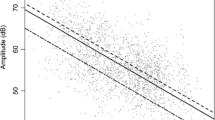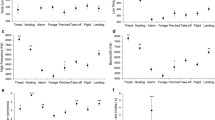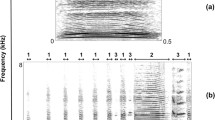Abstract
Quantitative assessments of the structure of vocalizations are a fundamental prerequisite to understand a species’ vocal communication system and, more broadly, the selective pressures shaping vocal repertoires. For example, to reduce ambiguity in signal interpretation in the absence of auxiliary visual cues, species in densely vegetated habitats should exhibit more discrete vocal signals than species in open habitats. To test this “ambiguity reduction hypothesis”, we conducted the first quantitative assessment of the rumble vocalizations of the forest elephant. Based on 686 forest elephant rumbles recorded with autonomous acoustic recording units at four sites across Central Africa, we used model-based cluster analyses paired with subsequent evaluation of cluster-discreteness and discriminant function analyses to quantify the structure of rumbles based on 23 source- and filter-related acoustic parameters. Model-based cluster analyses suggest that rumbles can be classified into five to eight types. Similar to previous findings in savannah elephants and contrary to the ambiguity reduction hypothesis, average silhouette coefficients below 0.34 indicated that these rumble types were highly intergraded. However, discriminant function analyses predicted rumble types with at least 75% accuracy whereby the location of the minimum fundamental frequency, middle slope and peak frequency contributed most to separation between types. In line with an increasing number of studies highlighting that a distinction between discrete and graded repertoires may have little biological significance, we propose that ambiguity reduction may take place through the evolution of perceptual and cognitive mechanisms, rather than acting on vocal production.




Similar content being viewed by others
References
August PV, Anderson JG (1987) Mammal sounds and motivation-structural rules: a test of the hypothesis. J Mammal 68:1–9
Bagley KR, Goodwin TE, Rasmussen LEL, Schulte BA (2006) Male African elephants, Loxodonta africana, can distinguish oestrous status via urinary signals. Anim Behav 71:1439–1445. https://doi.org/10.1016/j.anbehav.2006.01.003
Baotic A, Stoeger AS (2017) Sexual dimorphism in African elephant social rumbles. PLoS One 12:e0177411
Barreda S (2015) phonTools: functions for phonetics in R. R Package Version 02-21
Bates LA, Sayialel KN, Njiraini NW et al (2007) Elephants classify human ethnic groups by odor and garment color. Curr Biol 17:1938–1942. https://doi.org/10.1016/j.cub.2007.09.060
Bates LA, Sayialel KN, Njiraini NW et al (2008) African elephants have expectations about the locations of out-of-sight family members. Biol Lett 4:34–36. https://doi.org/10.1098/rsbl.2007.0529
Baugh AT, Akre KL, Ryan MJ (2008) Categorical perception of a natural, multivariate signal: mating call recognition in túngara frogs. Proc Natl Acad Sci 105:8985–8988
Blumstein DT, Armitage KB (1997) Does sociality drive the evolution of communicative complexity? A comparative test with ground-dwelling sciurid alarm calls. Am Nat 150:179–200. https://doi.org/10.1086/286062
Boncoraglio G, Saino N (2006) Habitat structure and the evolution of bird song: a meta-analysis of the evidence for the acoustic adaptation hypothesis. Funct Ecol 21:134–142. https://doi.org/10.1111/j.1365-2435.2006.01207.x
Bouchet H, Blois-Heulin C, Pellier A-S et al (2012) Acoustic variability and individual distinctiveness in the vocal repertoire of red-capped mangabeys (Cercocebus torquatus). J Comp Psychol 126:45
Bouchet H, Blois-Heulin C, Lemasson A (2013) Social complexity parallels vocal complexity: a comparison of three non-human primate species. Frontiers in Psychology 4:390. https://doi.org/10.3389/fpsyg.2013.00390
Caves EM, Brandley NC, Johnsen S (2018) Visual acuity and the evolution of signals. Trends Ecol Evol 33:358–372. https://doi.org/10.1016/j.tree.2018.03.001
Cheney DL, Seyfarth RM (1982) How vervet monkeys perceive their grunts: field playback experiments. Anim Behav 30:739–751. https://doi.org/10.1016/S0003-3472(82)80146-2
Dobson AJ, Barnett A (2008) An introduction to generalized linear models. CRC Press, Boca Raton
Elowson AM, Snowdon CT (1994) Pygmy marmosets, Cebuella pygmaea, modify vocal structure in response to changed social environment. Anim Behav 47:1267–1277. https://doi.org/10.1006/anbe.1994.1175
Ey E, Fischer J (2009) The “acoustic adaptation hypothesis”—a review of the evidence from birds, anurans and mammals. Bioacoustics 19:21–48. https://doi.org/10.1080/09524622.2009.9753613
Ey E, Rahn C, Hammerschmidt K, Fischer J (2009) Wild female olive baboons adapt their grunt vocalizations to environmental conditions. Ethology 115:493–503. https://doi.org/10.1111/j.1439-0310.2009.01638.x
Fant G (1981) The source filter concept in voice production. STL QPSR 1:21–37
Field A (2009) Discovering statistics using SPSS. Sage publications
Fischer J (1998) Barbary macaques categorize shrill barks into two call types. Anim Behav 55:799–807
Fischer J, Hammerschmidt K, Cheney DL, Seyfarth RM (2001) Acoustic features of female chacma baboon barks. Ethology 107:33–54. https://doi.org/10.1111/j.1439-0310.2001.00630.x
Fishlock V, Lee PC (2013) Forest elephants: fission–fusion and social arenas. Anim Behav 85:357–363
Fitch W (2006) Production of vocalizations in mammals. Vis Commun 3:145
Fraley C, Raftery AE (2006) MCLUST version 3: an R package for normal mixture modeling and model-based clustering
Freeberg TM (2016) Social complexity can drive vocal complexity. Psychol Sci 17(7):557–561
Hedwig D, Hammerschmidt K, Mundry R et al (2014) Acoustic structure and variation in mountain and western gorilla close calls: a syntactic approach. Behaviour 151:1091–1120
Hedwig D, Mundry R, Robbins MM, Boesch C (2015) Audience effects, but not environmental influences, explain variation in gorilla close distance vocalizations—a test of the acoustic adaptation hypothesis. Am J Primatol 77:1239–1252
Hedwig D, DeBellis M, Wrege PH (2018) Not so far: attenuation of low-frequency vocalizations in a rainforest environment suggests limited acoustic mediation of social interaction in African forest elephants. Behav Ecol Sociobiol 72:33. https://doi.org/10.1007/s00265-018-2451-4
Horn JL (1965) A rationale and test for the number of factors in factor analysis. Psychometrika 30:179–185
Keen SC, Shiu Y, Wrege PH, Rowland ED (2017) Automated detection of low-frequency rumbles of forest elephants: a critical tool for their conservation. J Acoust Soc Am 141:2715–2726. https://doi.org/10.1121/1.4979476
Keenan S, Lemasson A, Zuberbühler K (2013) Graded or discrete? A quantitative analysis of Campbell’s monkey alarm calls. Anim Behav 85:109–118. https://doi.org/10.1016/j.anbehav.2012.10.014
King LE, Soltis J, Douglas-Hamilton I et al (2010) Bee threat elicits alarm call in African elephants. PLoS One 5:e10346. https://doi.org/10.1371/journal.pone.0010346
Lachenbruch PA, Mickey MR (1968) Estimation of error rates in discriminant analysis. Technometrics 10:1–11
Langbauer WR (2000) Elephant communication. Zoo Biol 19:425–445. https://doi.org/10.1002/1098-2361(2000)
Langbauer WR, Payne KB, Charif RA et al (1991) African elephants respond to distant playbacks of low-frequency conspecific calls. J Exp Biol 157:35–46
Le Prell CG, Hauser MD, Moody DB (2002) Discrete or graded variation within rhesus monkey screams? Psychophysical experiments on classification. Anim Behav 63:47–62. https://doi.org/10.1006/anbe.2001.1888
Lemasson A, Hausberger M (2011) Acoustic variability and social significance of calls in female Campbell’s monkeys (Cercopithecus campbelli campbelli). J Acoust Soc Am 129:3341–3352
Leong K, Ortolani A, Graham L, Savage A (2003a) The use of low-frequency vocalizations in African elephant (Loxodonta africana) reproductive strategies. Horm Behav 43:433–443. https://doi.org/10.1016/S0018-506X(03)00025-4
Leong KM, Ortolani A, Burks KD et al (2003b) Quantifying acoustic and temporal characteristics of vocalizations for a group of captive African elephants Loxodonta africana. Bioacoustics 13:213–231
Lieberman P, Blumstein SE (1988) Speech physiology, speech perception, and acoustic phonetics. Cambridge University Press, Cambridge
Markel J, Gray A (1976) Linear prediction of speech. Springer, New York
Marler P (1967) Animal communication signals: we are beginning to understand how the structure of animal signals relates to the function they serve. Science 157:769–774. https://doi.org/10.1126/science.157.3790.769
Marler P (1976) Social organization, communication and graded signals: the chimpanzee and the gorilla. Growing points in ethology. Cambridge University Press, Oxford
Marler P (1977) The structure of animal communication sounds. Recognition of complex acoustic signals. Dahlem Konferenzen, Berlin, pp 17–35
Marler P, Kavanaugh JF, Cutting JE (1975) On the origin of speech from animal sounds. Role Speech Lang 1975:11–37
McComb K, Moss C, Sayialel S, Baker L (2000) Unusually extensive networks of vocal recognition in African elephants. Anim Behav 59:1103–1109. https://doi.org/10.1006/anbe.2000.1406
McComb K, Reby D, Baker L et al (2003) Long-distance communication of acoustic cues to social identity in African elephants. Anim Behav 65:317–329. https://doi.org/10.1006/anbe.2003.2047
McComb K, Semple S (2005) Coevolution of vocal communication and sociality in primates. Biol Lett 1(4):381–385
McCowan B, Reiss D (1995) Whistle contour development in captive-born infant bottlenose dolphins (Tursiops truncatus): role of learning. J Comp Psychol 109:242
Mitani JC, Brandt KL (1994) Social factors influence the acoustic variability in the long-distance calls of male chimpanzees. Ethology 96:233–252
Mitani JC, Hunley KL, Murdoch ME (1999) Geographic variation in the calls of wild chimpanzees: a reassessment. Am J Primatol 47(2):133–151
Morris-Drake A, Mumby HS (2018) Social associations and vocal communication in wild and captive male savannah elephants Loxodonta africana. Mammal Rev 48:24–36. https://doi.org/10.1111/mam.12106
Morton ES (1975) Ecological sources of selection on avian sounds. Am Nat 109:17–34
Morton ES (1977) On the occurrence and significance of motivation-structural rules in some bird and mammal sounds. Am Nat 111:855–869
Morton ES (1982) Grading, discreteness, redundancy, and motivation-structural rules. Acoust Commun Birds 1:183–212
Moss CJ, Croze H, Lee PC (2012) The amboseli elephants: a long-term perspective on a long-lived mammal. University of Chicago Press, Chicago
Nelson DA, Marler P (1989) Categorical perception of a natural stimulus continuum: birdsong. Science 244:976–978
Payne KB, Thompson M, Kramer L (2003) Elephant calling patterns as indicators of group size and composition: the basis for an acoustic monitoring system. Afr J Ecol 41:99–107. https://doi.org/10.1046/j.1365-2028.2003.00421.x
Pettigrew JD, Manger PR (2008) Retinal ganglion cell density of the black rhinoceros (Diceros bicornis): calculating visual resolution. Vis Neurosci 25:215–220. https://doi.org/10.1017/S0952523808080498
Pettigrew JD, Bhagwandin A, Haagensen M, Manger PR (2010) Visual acuity and heterogeneities of retinal ganglion cell densities and the tapetum lucidum of the African Elephant (Loxodonta africana). Brain Behav Evol 75:251–261. https://doi.org/10.1159/000314898
Plotnik JM, Shaw RC, Brubaker DL et al (2014) Thinking with their trunks: elephants use smell but not sound to locate food and exclude nonrewarding alternatives. Anim Behav 88:91–98. https://doi.org/10.1016/j.anbehav.2013.11.011
Plotnik JM, Brubaker DL, Dale R et al (2019) Elephants have a nose for quantity. Proc Natl Acad Sci 116:12566. https://doi.org/10.1073/pnas.1818284116
Pollard KA, Blumstein DT (2012) Evolving communicative complexity: insights from rodents and beyond. Philos Trans R Soc Biol 367:1869–1878
Poole JH (1999) Signals and assessment in African elephants: evidence from playback experiments. Anim Behav 58:185–193
Poole JH, Payne K, Langbauer WR, Moss CJ (1988) The social contexts of some very low frequency calls of African elephants. Behav Ecol Sociobiol 22:385–392
Poole JH, Tyack PL, Stoeger-Horwath AS, Watwood S (2005) Animal behaviour: elephants are capable of vocal learning. Nature 434:455–456. https://doi.org/10.1038/434455a
R Core Team (2016) R: a language and environment for statistical computing. R Foundation for Statistical Computing, Vienna
Rendall D, Seyfarth RM, Cheney DL, Owren MJ (1999) The meaning and function of grunt variants in baboons. Anim Behav 57:583–592
Revelle W (2018) psych: procedures for psychological, psychometric, and personality research. Northwestern University, Evanston
Rousseeuw PJ (1987) Silhouettes: a graphical aid to the interpretation and validation of cluster analysis. J Comput Appl Math 20:53–65. https://doi.org/10.1016/0377-0427(87)90125-7
Schwarz G (1978) Estimating the dimension of a model. Ann Stat 6:461–464. https://doi.org/10.1214/aos/1176344136
Shyan-Norwalt MR, Peterson J, Milankow King B et al (2010) Initial findings on visual acuity thresholds in an African elephant (Loxodonta africana). Zoo Biol 29:30–35. https://doi.org/10.1002/zoo.20259
Soltis JM, Savage A, Leong KM (2004) How many rumbles are there? Acoustic variation and individual identity in the rumble vocalizations of African elephants (Loxodonta africana). J Acoust Soc Am 115:2555. https://doi.org/10.1121/1.4783864
Soltis J, Leong K, Savage A (2005a) African elephant vocal communication II: rumble variation reflects the individual identity and emotional state of callers. Anim Behav 70:589–599. https://doi.org/10.1016/j.anbehav.2004.11.016
Soltis J, Leong K, Savage A (2005b) African elephant vocal communication I: antiphonal calling behaviour among affiliated females. Anim Behav 70:579–587. https://doi.org/10.1016/j.anbehav.2004.11.015
Soltis J, Leighty KA, Wesolek CM, Savage A (2009) The expression of affect in african elephant (Loxodonta Africana) rumble vocalizations. J Comp Psychol 123:222–225
Soltis J, Blowers Tracy E, Savage A (2011) Measuring positive and negative affect in the voiced sounds of African elephants (Loxodonta africana). J Acoust Soc Am 129:1059–1066. https://doi.org/10.1121/1.3531798
Soltis J, King LE, Douglas-Hamilton I et al (2014) African elephant alarm calls distinguish between threats from humans and bees. PLoS One 9:e89403. https://doi.org/10.1371/journal.pone.0089403
Stoeger AS, Baotic A (2016) Information content and acoustic structure of male African elephant social rumbles. Sci Rep 6:27585. https://doi.org/10.1038/srep27585
Stoeger AS, Heilmann G, Zeppelzauer M et al (2012) Visualizing sound emission of elephant vocalizations: evidence for two rumble production types. PLoS One 7:e48907
Stoeger AS, Zeppelzauer M, Baotic A (2014) Age-group estimation in free-ranging African elephants based on acoustic cues of low-frequency rumbles. Bioacoustics 23:231–246. https://doi.org/10.1080/09524622.2014.888375
Stoeger-Horwath AS, Stoeger S, Schwammer HM, Kratochvil H (2007) Call repertoire of infant African elephants: first insights into the early vocal ontogeny. J Acoust Soc Am 121:3922–3931. https://doi.org/10.1121/1.2722216
Sugiura H (1993) Effects of proximity and behavioral context on acoustic variation in the coo calls of Japanese macaques. Am J Primatol 69:1412–1424. https://doi.org/10.1002/ajp.20447
Taylor AM, Reby D (2009) The contribution of source-filter theory to mammal vocal communication research. J Zool 280:221–236. https://doi.org/10.1111/j.1469-7998.2009.00661.x
Taylor AM, Charlton BD, Reby D (2016) Vocal production by terrestrial mammals: source, filter, and function. Vertebrate sound production and acoustic communication. Springer, Cham, pp 229–259
Thompson M (2009) African forest elephant (Loxodonta africana cyclotis) vocal behavior and its use in conservation. Cornell University, Cornell
Thompson ME, Schwager SJ, Payne KB (2010) Heard but not seen: an acoustic survey of the African forest elephant population at Kakum Conservation Area, Ghana. Afr J Ecol 48:224–231. https://doi.org/10.1111/j.1365-2028.2009.01106.x
Turkalo A, Fay J (1995) Studying forest elephants by direct observation. Pachyderm 1995:45–54
Venables WN, Ripley BD (2002) Modern applied statistics with S, 4th edn. Springer, New York
Wadewitz P, Hammerschmidt K, Battaglia D et al (2015) Characterizing vocal repertoires—hard vs. soft classification approaches. PLoS One 10:e0125785. https://doi.org/10.1371/journal.pone.0125785
Waser PM, Brown CH (1986) Habitat acoustics and primate communication. Am J Primatol 10:135–154. https://doi.org/10.1002/ajp.1350100205
Wesolek CM, Soltis J, Leighty KA, Savage A (2009) Infant African elephant rumble vocalizations vary according to social interactions with adult females. Bioacoustics 18:227–239. https://doi.org/10.1080/09524622.2009.9753603
White JW, Ruttenberg BI (2007) Discriminant function analysis in marine ecology: some oversights and their solutions. Mar Ecol Prog Ser 329:301–305
Wiley RH, Richards DG (1978) Physical constraints on acoustic communication in the atmosphere: implications for the evolution of animal vocalizations. Behav Ecol Sociobiol 3:69–94. https://doi.org/10.1007/BF00300047
Wood JD, McCowan B, Langbauer WR et al (2005) Classification of African elephant Loxodonta africana rumbles using acoustic parameters and cluster analysis. Bioacoustics 15:143–161
Acknowledgements
This study was supported by a grant to PHW from the US Fish and Wildlife Service, the Robert G. and Jane V. Engle Foundation, and through a generous gift from Lisa Yang to the Cornell Lab of Ornithology. Research clearance was approved by the Gabon government’s National Center for Scientific Research and Technology, by the Republic of Congo’s Ministry of Forestry, and by the Central African Republic’s Ministry of Education and Water and Forests. Special thanks go to Elizabeth D. Rowland, Andrea Turkalo, Frelcia Bambi, Phael Malonga, Terry Brncic and Herve Londo for superb assistance with data collection and Precious Woods Gabon for critical logistics support.
Author information
Authors and Affiliations
Corresponding author
Additional information
Publisher's Note
Springer Nature remains neutral with regard to jurisdictional claims in published maps and institutional affiliations.
Electronic supplementary material
Below is the link to the electronic supplementary material.
Rights and permissions
About this article
Cite this article
Hedwig, D., Verahrami, A.K. & Wrege, P.H. Acoustic structure of forest elephant rumbles: a test of the ambiguity reduction hypothesis. Anim Cogn 22, 1115–1128 (2019). https://doi.org/10.1007/s10071-019-01304-y
Received:
Revised:
Accepted:
Published:
Issue Date:
DOI: https://doi.org/10.1007/s10071-019-01304-y




